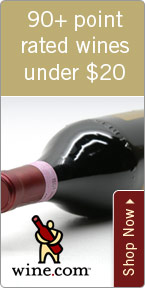Great Wine Is Truly Made In The Vineyard

Wednesday - September 22, 2010
| Share
 Del.icio.us
Del.icio.us
|
You’ve heard the saying before: “You can never have too much of a good thing.”
Some believe it is true for wine as well. But when it comes to yield from the vine, there are other schools of thought.
Every great winemaker knows that great wine is truly made in the vineyard. So it is of utmost importance for a vine grower to produce the best possible grapes with which a wine-maker can make wine. One of the ways that vine growers can do this is by controlling yield.
Yield is the amount of grapes produced per area of vine. In the U.S. we express this amount as tons per acre, whereas in Europe they use hectoliters per hectare (hl/ha). Approximately 18hl/ha is equivalent 1 ton/acre.
A vine naturally would like to produce as many grapes as possible in order to proliferate itself. And the vine has only so much energy to spend each year. If it spent its year trying to ripen 200 grape bunches per vine, it might not be able to do that really well. But if it had only 50 bunches per vine, it would be able to focus more energy into making those grapes ripen just right.
Just like humans, if we had 50 things to do at one time, we probably would not be able to do any one thing well, but if we had only 10 things to do at one time, we would be more successful.

|
This leads to the first philosophy of vine growers, “the lower the better.” By reducing yields a vine grower would naturally be able to concentrate more of the flavors in the grapes.
This is done by several methods. The first is by cutting off embryonic bunches of grapes from the vine after fruit setting. The benefit of this is that the vine does not have to spend the energy growing these bunches from the beginning. On the other hand, if there is inclement weather or other abnormalities such as a low amount of fruit, you may end up with very little wine.
Another method is what is called “green harvesting.” This consists of cutting off bunches of grapes when they are grown, but before they ripen, while they are still green. Some believe that the energy has already been spent on these bunches, but it is easier to know later in the season just how much fruit you will end up with.
Another technique to control yield naturally is to use a clone of a vine that naturally has lower yields.
There are certain clones known to produce less fruit but more concentrated fruit for particular varieties. Older vines also produce less fruit than younger ones. Older vines are certainly prized for their production. You may even see a label promote the fact that they use only “old vines’ in their wines, although the word “old” has no legal definition. The older a vine gets, the less fruit it produces.
On the other side of the coin, there is a school of thought that believes that a vine can produce fruit that has a high degree of concentration up to a certain point. If it goes over that yield, the quality will diminish. This is the “balanced vine” philosophy. That tipping point is different for each variety and can depend on its clonal heritage, age, soil type and even its location within a vineyard. The detail here is to know exactly where that tipping point is, and it takes a really good vine grower to know that.
So is it possible to have too much of a good thing? In grape yield, the answer is definitely yes. But I can think of a lot of other things that you just can’t get enough of.
Recommendations: 2008 Oroya ($10) This is called the “sushi wine” because it is designed to go really well with sushi, and it does. But it also is a wonderfully refreshing, light white that can start off a meal in the perfect way. 2007 Domaine Les Pallieres Gigondas “Terrasses du Diable” ($26) This may be the best this estate has ever made. Sweet, ripe, red fruits laced with savory spices and the smell of warm earth. Scintillating with a nice piece of grilled meat.
Roberto Viernes is a master sommelier. E-mail .(JavaScript must be enabled to view this email address)E-mail this story | Print this page | Comments (0) | Archive | RSS Comments (0) |
Most Recent Comment(s):












